Class 3 Maths Chapter 2 Solutions Question Answer Toy Joy
Toy Joy Class 3 Maths Question Answer
Toy Joy Class 3 Solutions
Let us Do (NCERT Textbook Pages 9-10)
Question 1.
Use old boxes (cubes and cuboids) and bottles (cylinders) to do craft work. Draw faces on them.
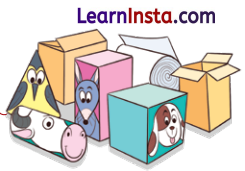
What did you draw on their faces?
Answer:
Do it yourself.
Question 2.
Jaya is building a rocket with her shapes.

What shapes has she used? How many of each?
- Cube: ___________
- Cuboid: ___________
- Cone: ___________
- Cylinder: ___________
Answer:
- Cube: 2
- Cuboid: 4
- Cone: 1
- Cylinder: 1
![]()
Question 3.
What shape is between the red cuboid and the yellow cuboid?
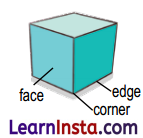
Answer:
Cylinder
Question 4.
What shape is on the top of the orange cylinder?
Answer:
A blue cube is on the top of the orange cylinder.
Question 5.
What shape is under the pink cone?
Answer:
A purple cube is under the pink cone.
Question 6.
Devika went to a shop and bought a toy engine. Here is Devika’s toy engine. It has many parts.
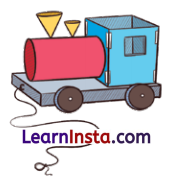
Count and fill.
- ___________ red cylinder(s)
- ___________ yellow cone(s)
- ___________ grey cuboid(s)
- ___________ blue cube(s)
Answer:
- 1 red cylinder(s)
- 2 yellow cone(s)
- 1 grey cuboid(s)
- 1 blue cube(s)
Let us Discuss (NCERT Textbook Page 10)
Question 1.
Here are some more toys from the toy shop. They are made up of different shapes.

What shapes are used in these toys?
Answer:

Let us Do (NCERT Textbook Pages 11-15)
Question 1.
Can you find these shapes in the classroom? Fill in the table with their names.

(a) Name the shape that you find the most. __________
(b) Name the shape that you find the least. __________
(c) Name the objects that are made up of more than one shape. __________
Answer:
Do it yourself.
![]()
Question 2.
Look at these shapes and answer the following questions.

• Circle ![]() the cubes.
the cubes.
• Put a tick ![]() against the shapes that are cones.
against the shapes that are cones.
• Put a cross ![]() against the shapes that are cylinders.
against the shapes that are cylinders.
• Put a box ![]() around the cuboids.
around the cuboids.
Answer:
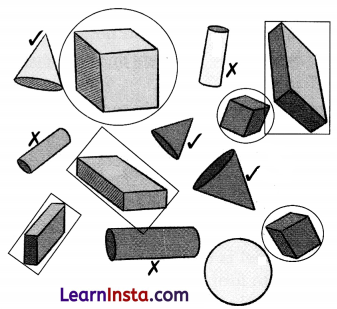
Question 3.
Name the shapes.
- with no edges. __________
- with only flat faces. __________
- with only curved faces. __________
- with both straight and curved edges. __________
- with both flat and curved faces. __________
Answer:
- with no edges. Spheres
- with only flat faces. Cubes, Cuboids
- with only curved faces. Spheres
- with both straight and curved edges. Spoon, Blades of a Fan, etc.
- with both flat and curved faces. Cylinders, Cones
Question 4.
Which shapes can you build?

Answer:
Do it yourself.
Question 5.
Try to make these shapes using cubes.

Answer:
Do it yourself.
Question 6.
In what ways are these shapes the same? In what ways are they different?
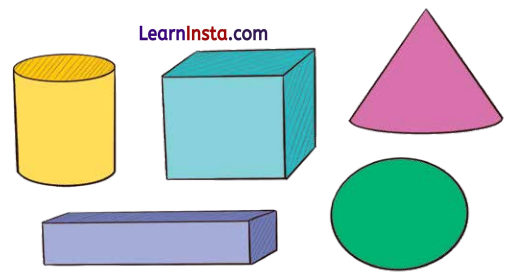
Answer:
| Similarities | Differences |
| All the shapes are 3-dimensional shapes that can occupy space. We can touch, feel and hold them. | Some shapes are with flat faces (Cube and cuboid) some are with flat and curved faces (cylinder and cone) and one is with only curved face (sphere). |
Question 7.
Look at a die. The faces have 1 to 6 dots.
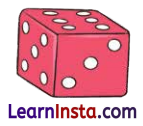
What number is on:
- the face opposite number 1? _______
- the face opposite number 2? _______
- the face opposite number 3? _______
- What pattern do you notice? _______
Answer:
- 6
- 5
- 4
- The Sum of the numbers on the opposite sides is always 7.
![]()
Question 8.
In what order is this model built?


Answer:
The model is built by first assembling three cuboid to form a staircase, follow by placing two slightly bigger cuboid under the ends of a large cuboid, then a large cuboid is placed a top the four cylinders that have been placed at the four corners over the cuboid, and finally, four cones are over the cuboid at four corners.

Question 9.
In how many different ways can you join 3 cubes? Try and see.

Answer:
Cuboid
Question 10.
Name the shapes used in these models. Describe how the shapes are arranged to make them.

Answer:
(a) Four cuboids are arranged vertically with one at the bottom, two placed side by side in the middle, leaving a small gap between then, and one cuboid place on top.
(b) 5 cuboids of the same size are placed on top of each other and then a bigger cuboid is place on top of them.
(c) 6 cuboids of the same size are stacked directly out top of each other, forming a tower like structure.
(d) There cuboids of the same size are stacked vertically with each successive cuboid placed slightly.
Question 11.
Use six dice ![]() to make the following shapes:
to make the following shapes:
(a) A Cuboid
(b) A tower
(c) Any other shape of your choice
Answer:
